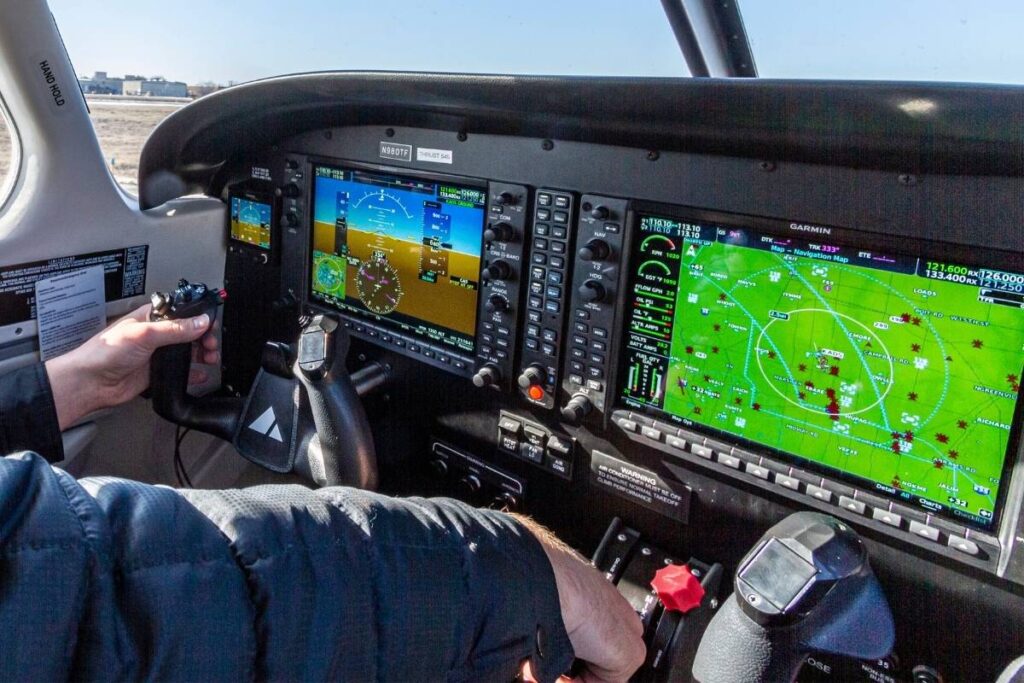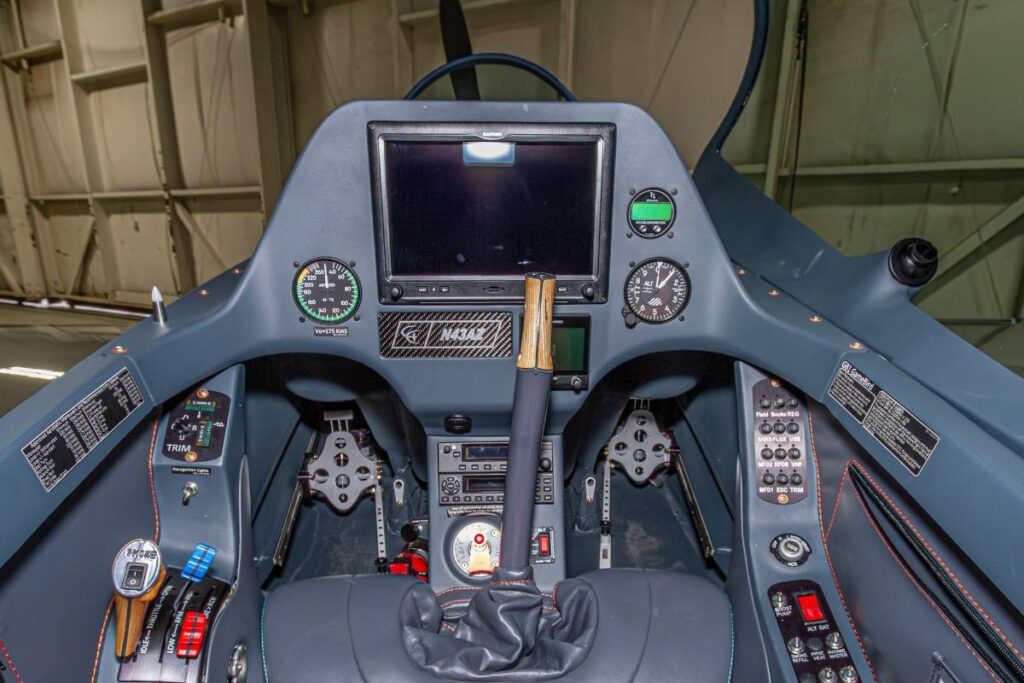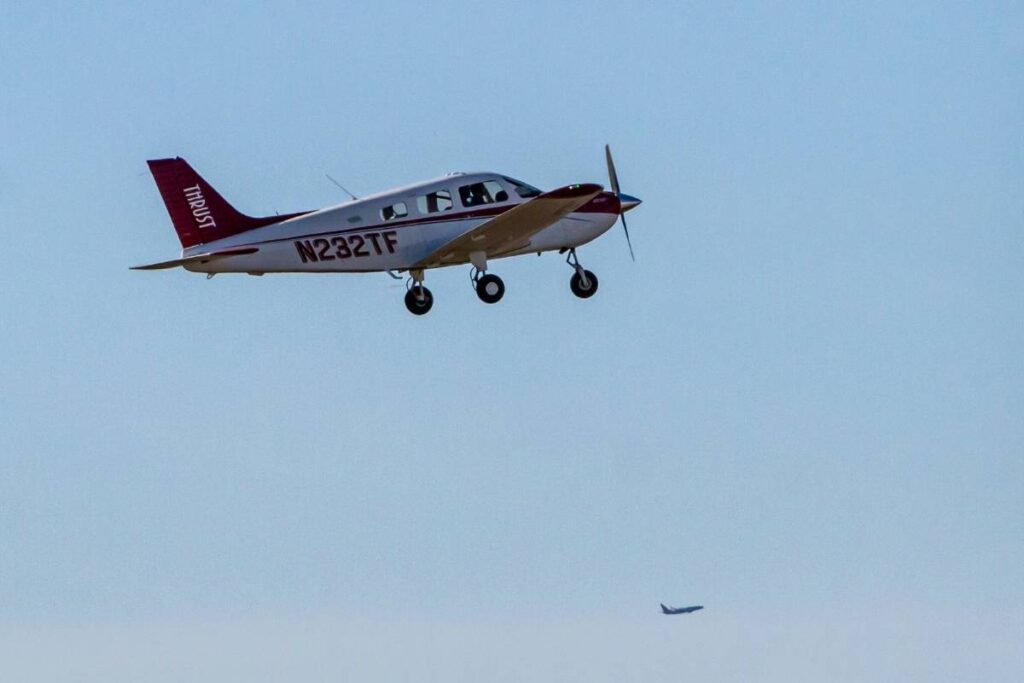Many new pilots find the concept of airspeed and types of airspeed difficult to grasp. In this article I hope to simplify things for you.
Ever wonder how your magical airspeed indicator works? It’s a lot more complicated than the speedometer in your car, that’s for sure!
Here’s a look at the types of airspeed indicators found in planes, how they work, the markings on them, and the types of airspeeds that pilots need to know.
Types of Airspeed Indicators
Traditional round gauges are found in many aircraft. The pointer moves clockwise to indicate an increase in airspeed. The instrument may be calibrated to show statute miles per hour, knots (nautical miles per hour), or sometimes both.
A true airspeed indicator has a dial for inputting the current pressure altitude and outside air temperature (OAT). True airspeed (TAS) is displayed on the instrument only when the correct inputs have been made.
Modern glass cockpits have Primary Flight Displays (PFDs) that incorporate a tape-style airspeed indicator on the left-hand side. The tape scrolls up and down to indicate changes in airspeed, with the current speed centered and in a highlighted box.

Trend lines show changes and indicate what the airspeed will be six seconds in the future.
The computer calculates true airspeed and displays it at the bottom of the airspeed tape. Since glass cockpits are also connected to GPS, ground speed is usually shown on the PFD as well.
How Do Airspeed Indicators Work?
The airspeed indicator is part of the aircraft’s pitot-static system. The system includes the static port, which measures air pressure outside the aircraft that changes with altitude, and the pitot tube, which is pointed forward and measures the air pressure that increases as speed increases.
The airspeed indicator is a simple pressure instrument that measures the difference in pressure between the static port (stationary or not moving air pressure) and the pitot tube (dynamic or moving air pressure).
As the aircraft flies faster and faster, the pressure coming into the pitot tube increases, and the instrument shows higher speed. The static port keeps the reading more accurate, allowing the instrument to function at any altitude.
Digital glass cockpits have a computer module that serves the function of the pitot-static system and works in the same basic ways—there are still physical pitot tubes and static ports.
But the computer takes digital measurements instead of mechanical pressure readings.
The computer that translates it all is the Air Data Computer (ADC).
Airspeed Indicator Markings
Important airspeeds for the aircraft are permanently marked on the airspeed indicator using color arcs and lines.
When referring to speed markings, ‘lower limits’ refer to slower speeds, while ‘upper limits’ refer to faster speeds. These speeds are shown regardless of whether you’re looking at a round gauge or tape-style airspeed indicator.
The white arc shows the flap operating range. It starts at the slowest speed you can fly with flaps extended, otherwise known as stall speed “dirty” or Vso, and goes up to the fastest the plane can fly with the flaps extended or Vfe.
The green arc shows the normal operating speeds. It starts at the slowest speed the plane flies, or stall speed “clean” (Vs1), and goes up to the maximum normal operating speed, or Vno. Vno is also called the maximum structural cruising speed.
The yellow arc is referred to as the caution range. It should only be entered in smooth air. It starts at Vno and goes up to the red line.
The red line is the never-exceed speed, or Vne. Vne is an aircraft limitation—flying faster than this speed will damage the aircraft.
Multi-engine aircraft have two more lines depicted on their airspeed indicators. These are safety speeds for when one engine has failed.

The lower red line is for Vmc, or the minimum controllable airspeed.
Vyse is the best rate of climb with a single engine.
There are quite a few important V-speeds that are not depicted on the airspeed indicator, like landing gear operating limits (Vlo and Vle), best angle and best rate of climb (Vx and Vy), and maneuvering speed (Va).
These speeds are placarded elsewhere in the cockpit, usually near the appropriate control.
Types of Airspeed
Just like the altimeter, the airspeed indicator does its best.
However, a good pilot knows when it may be less than accurate and plans accordingly. To understand what an airspeed indicator tells you, you must understand the difference between the types of airspeeds.
Then, you can fill in the missing pieces to calculate the one you need.
Indicated Airspeed
Indicated airspeed (IAS or KIAS if in knots) is read off the instrument face. It’s the least accurate measure of airspeed but the easiest to get. You can dig into indicated airspeed vs true airspeed in our other post.
The important V-speeds are marked and memorized in KIAS to keep it simple while flying.
Calibrated Airspeed
Calibrated airspeed (CAS or KCAS) is indicated airspeed corrected for instrument errors. These errors result from the different angles of attack required to maintain different airspeeds.
If the plane is pitched up at a high angle of attack to fly slowly (imagine flying in slow flight clean on a training flight), then air is no longer entering the pitot tube at the optimum angle. Your airspeed reading will be slightly off.
The same would occur at very high speeds with the plane pitched down.
Manufacturers mount the pitot tube to show the most accurate indications during a normal cruise.

As a result, CAS in small aircraft can often be disregarded during the normal course of a flight. It becomes much more important in planes that change their angles of attack greatly with different flap settings.
No matter what plane you fly, you can find tables to correct your indicated airspeed to calibrated airspeed in the Performance section of the flight manual (POH/AFM).
Equivalent Airspeed
Equivalent airspeed is a correction made for the air being compressed forward of the pitot tube at very high speeds.
It’s only used on faster turboprops or jet aircraft and can be disregarded for trainers.
A table is included in the Performance section of the POH/AFM to correct for them.
True Airspeed
True airspeed (TAS or KTAS) is the most accurate measure of airspeed.
To find it, you must correct your calibrated or equivalent airspeed for non-standard pressure and temperatures. In other words, it’s your airspeed corrected for your density altitude.
You can find the TAS in several ways. Some airplanes display it on their own (or at least have a correction card built into the airspeed indicator). You can also use an E6B flight computer, either manual or electronic.
Ground Speed
It’s not technically an airspeed, but it’s still important!
While all of the speeds above are important steps along the way, only one speed matters when you’re flying a cross country—the speed you fly between Point A and Point B, otherwise known as your ground speed (GS).
Ground speed takes TAS and corrects it for the effects of the wind on the plane. Your GS will be faster with tailwinds and slower with headwinds.
A GPS or other navigation equipment is required in the cockpit to indicate your GS.
You can also calculate it manually by timing how long it takes you to fly between two known points and then using the “Speed=Distance/Time” formula.
On the ground during pre-flight planning, you can estimate your GS by calculating TAS and applying the forecast winds aloft with the help of your flight computer.
- About the Author
- Latest Posts
Jarrod Roberts brings a wealth of experience to the Thrust Flight team, with a flying career spanning over 15 years. His journey in aviation began with a BS in Aeronautical Science from Texas A&M Central. After working as a flight instructor, he joined SkyWest as a First Officer and then later upgraded to Captain. He now flies for a legacy airline. Jarrod also serves as the Chief Pilot here at Thrust Flight where he guides our team of flight instructors in delivering top-tier training to our many Zero Time to Airline students.


Leave a Reply